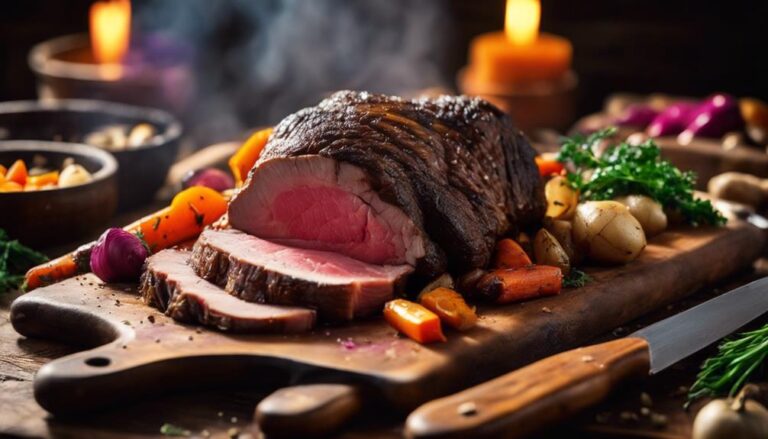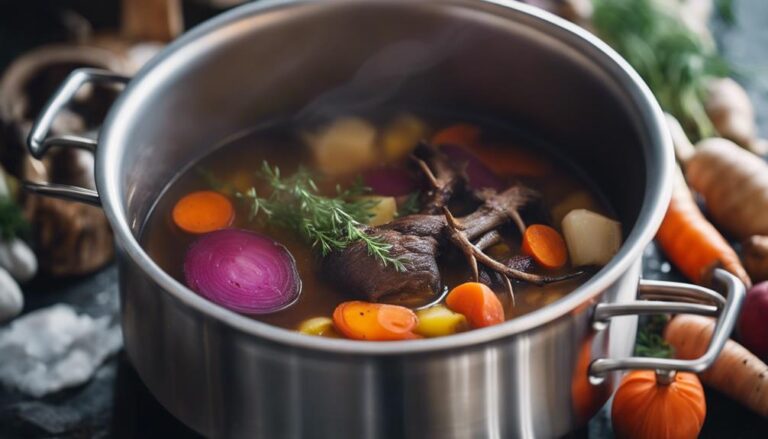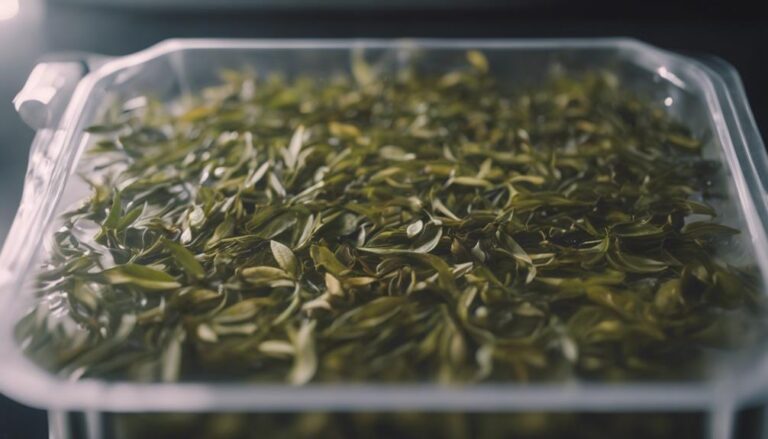Sous Vide Rhubarb Compote
To guarantee sous vide rhubarb compote, vacuum-seal rhubarb pieces with sugar and lemon zest. Cook in a water bath at 183°F for 45 minutes. This precise cooking method preserves rhubarb's tangy flavors while breaking it down to a luscious texture. Perfect for pairing with desserts or savory dishes, the sous vide technique guarantees consistent results. Ready to discover the secrets behind this culinary gem?
What You Will Learn Here
- Sous vide cooking retains rhubarb's flavor and texture.
- Precise temperature control ensures consistent results.
- Cooking rhubarb sous vide intensifies its natural sweetness.
- Vacuum-sealing rhubarb with sugar enhances flavors.
- Sous vide method preserves rhubarb's color and nutrients.
Rhubarb's Origins
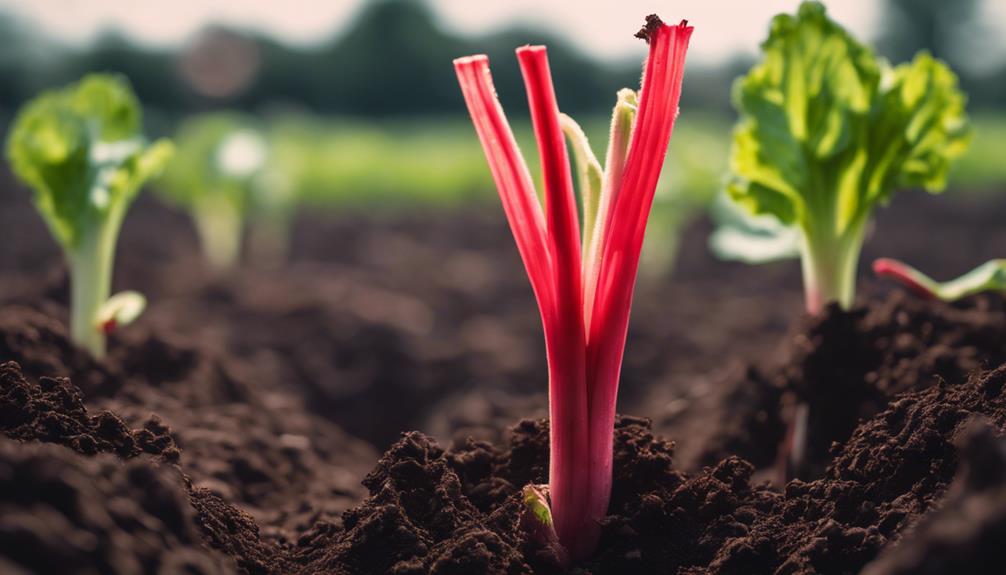
Rhubarb holds a significant place in history due to its early medicinal uses and symbolic value in different cultures. Understanding the cultivation practices and regions where rhubarb thrives can offer insights into its adaptability and preferred growing conditions.
Exploring rhubarb's culinary versatility and various traditional and modern uses can shed light on its enduring popularity in diverse cuisines.
Rhubarb's Historical Significance
Originally cultivated in ancient China as a medicinal herb, the plant we now know as rhubarb has a rich historical significance that dates back thousands of years. This herb was highly valued for its medicinal uses in traditional Chinese medicine, believed to have properties that aid digestion and treat various ailments.
Over time, rhubarb spread to other regions like Europe, where it became popular for its culinary applications. Its tart flavor and vibrant color made it a sought-after ingredient in pies, jams, and compotes.
Rhubarb's journey from a medicinal herb to a beloved culinary staple showcases its versatility and enduring appeal throughout history. Its evolution reflects the intersection of health, culture, and taste, making it a fascinating botanical specimen with a storied past.
Cultivation Practices and Regions
Cultivating rhubarb necessitates specific environmental conditions and meticulous attention to soil quality and moisture levels to guarantee ideal growth and development.
Rhubarb is a hardy perennial plant that thrives in cool climates, requiring temperatures between 40°F and 75°F for best growth. It's essential to plant rhubarb in well-drained soil with a pH level between 5.0 and 6.5 to prevent root rot and promote nutrient uptake.
Cultivation techniques involve planting rhubarb crowns in early spring or fall, spacing them about 3 feet apart to allow for their expansive root systems. Regular watering is important, especially during dry spells, to maintain consistent soil moisture levels.
Rhubarb is commonly grown in regions with cold winters and mild summers, making it a popular crop in temperate climates worldwide.
Culinary Versatility and Uses
With a history dating back to ancient China and used in culinary traditions around the world, rhubarb has evolved into a versatile ingredient with a multitude of culinary uses.
When it comes to innovative techniques like sous vide desserts, rhubarb shines in creating beautifully tender compotes and preserves. Its tart flavor profile adds a unique twist to traditional sweet dishes, making it a favorite among chefs experimenting with modern culinary methods.
Additionally, rhubarb is a popular choice for seasonal drinks, elevating cocktails with its invigorating and lively taste. Whether you're looking to add a tangy kick to your desserts or create vibrant rhubarb cocktails, this versatile ingredient offers a wide range of possibilities for culinary exploration.
Rhubarb's Versatile Flavor
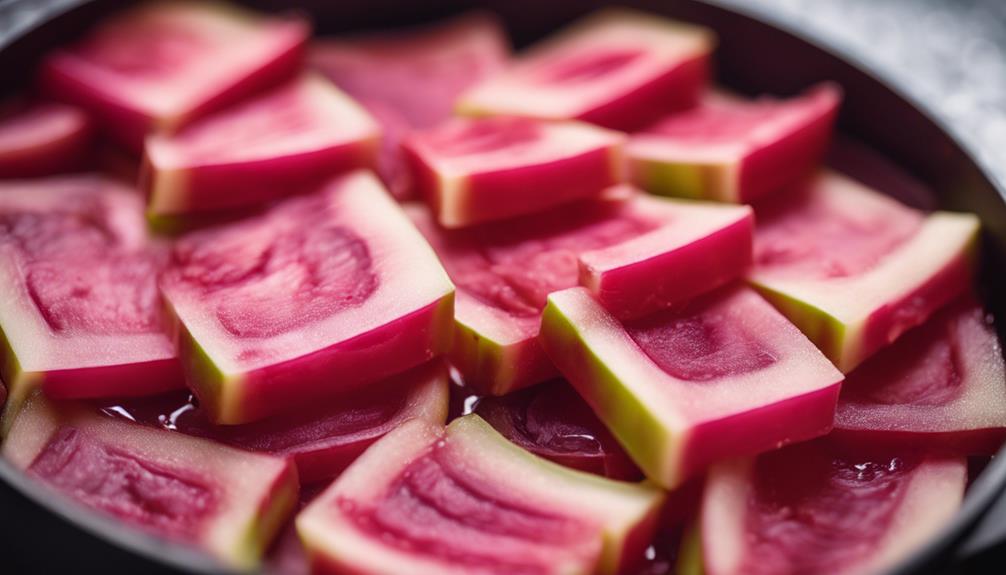
How does rhubarb's versatile flavor make it a standout ingredient in various culinary creations? Rhubarb's unique taste profile brings a tangy and slightly sour note that pairs exceptionally well with both sweet and savory dishes. Here are four ways this versatility shines:
- Rhubarb Cocktails: Rhubarb's tartness adds an invigorating twist to cocktails, balancing out the sweetness of other ingredients like sugar or fruits, creating a well-rounded drink experience.
- Rhubarb Preserves: When used in preserves, rhubarb's flavor transforms into a delightful balance of sweet and sour, making it a perfect spread for toast, pastries, or even as a topping for desserts like ice cream.
- Rhubarb Salsa: The tangy flavor of rhubarb in a salsa brings a unique twist to traditional recipes, adding a zesty kick to dishes like grilled fish or tacos.
- Rhubarb Compote: Rhubarb's versatility shines in compotes, where its tanginess can complement both sweet and savory dishes, making it a versatile condiment for various culinary creations.
Tried-and-True Rhubarb Dishes
You can explore a range of classic rhubarb dishes that have stood the test of time. Consider trying out recipes like Sous Vide Rhubarb Mousse, Sous Vide Rhubarb Tartlets, and Sous Vide Rhubarb Chutney to experience the traditional flavors of rhubarb in new and exciting ways.
These tried-and-true dishes showcase the versatility of rhubarb and offer delicious options for incorporating this unique ingredient into your cooking repertoire.
Sous Vide Rhubarb Mousse
One popular and well-received approach to incorporating rhubarb into a delightful dessert is by preparing a velvety Sous Vide Rhubarb Mousse.
- Texture Contrast: The smooth mousse pairs perfectly with crunchy toppings for a delightful mouthfeel.
- Flavor Infusion: Sous vide allows for precise infusion of flavors, ensuring a rich and intense rhubarb taste.
- Customization: Experiment with different spices or herbs during the sous vide process to create unique flavor profiles.
- Garnish Creativity: Elevate your mousse with artistic garnishes like edible flowers or citrus twists for a visually stunning presentation.
Sous Vide Rhubarb Mousse offers a sophisticated dessert option that combines the tartness of rhubarb with a luxurious texture, making it a versatile and elegant choice for any occasion.
Sous Vide Rhubarb Tartlets
Moving on from the luxurious Sous Vide Rhubarb Mousse, explore the world of tried-and-true rhubarb dishes with the delectable Sous Vide Rhubarb Tartlets. These tartlets offer a perfect balance of tartness and sweetness, showcasing rhubarb in all its glory. Here's what makes them a delightful choice:
- Tartlet presentation: The individual servings of these tartlets make for an elegant and visually appealing dessert.
- Flavor infusion: Sous vide cooking allows for precise flavor infusion, ensuring each bite bursts with rhubarb goodness.
- Texture control: By cooking the rhubarb sous vide, you can control the texture to achieve the perfect balance between tender and slightly firm.
- Flavor retention: The sous vide method helps retain the vibrant flavors of rhubarb, ensuring a taste sensation in every bite.
Sous Vide Rhubarb Chutney
When preparing Sous Vide Rhubarb Chutney, the controlled cooking process guarantees excellent flavor extraction and texture consistency, resulting in a harmonious blend of sweet and tangy notes.
- Balanced Flavors: The slow cooking method of sous vide allows the rhubarb chutney flavors to develop fully, creating a well-balanced taste profile.
- Versatile Usage: This sous vide rhubarb relish can be used as a condiment for meats, a topping for desserts, or a spread for sandwiches, adding a unique twist to various dishes.
- Texture Perfection: The precise temperature control in sous vide cooking ensures that the rhubarb chutney maintains its texture integrity, providing a delightful mouthfeel.
- Enhanced Preservation: The vacuum-sealed bags used in sous vide cooking help maintain the freshness of the rhubarb chutney flavors, allowing you to enjoy them for longer periods.
Sous Vide Temperature Guidelines
When sous vide cooking, the temperature you set is essential for achieving desired results. Maintaining a precise water bath guarantees consistent cooking throughout.
Following recommended temperature guidelines is key to perfecting your sous vide dishes.
Ideal Sous Vide Temps
To achieve the best results when cooking sous vide, it's essential to adhere to precise temperature guidelines for the most important cooking outcomes. Sous vide techniques play a vital role in flavor enhancement by ensuring that ingredients are cooked evenly and retain their natural taste.
The sous vide temperature and cooking methods are key factors that determine the texture, taste, and overall quality of the final dish. By setting the ideal sous vide temperature, you can achieve precise control over the cooking process, resulting in perfectly cooked food that's tender and flavorful.
Experimenting with different temperatures and cooking times can help you discover the ideal sous vide temps for various ingredients, allowing you to elevate your culinary creations with consistency and precision.
Precise Water Bath
For precise water bath control in sous vide cooking, maintain strict adherence to temperature guidelines to guarantee the best results. When employing water bath techniques in sous vide, temperature precision is essential for achieving consistent and delicious dishes.
The water bath serves as the medium through which heat is evenly distributed around the ingredients, ensuring they cook uniformly. To achieve this, set your sous vide equipment to the exact temperature specified in your recipe.
Even minor deviations can impact the final outcome, so it's important to monitor the water temperature carefully throughout the cooking process. By mastering the art of maintaining precise water bath temperatures, you can elevate your sous vide cooking to new levels of excellence.
Consistent Cooking Results
Maintaining precise temperature control in sous vide cooking is crucial for achieving consistent and reliable cooking results. Sous vide techniques rely on accuracy to guarantee flavor consistency and texture control.
By following sous vide temperature guidelines, you can enhance the quality of your dishes. Precision cooking plays a critical role in sous vide preparation, allowing you to achieve ideal results every time.
The controlled temperature environment ensures that your food cooks evenly and retains its natural flavors. Whether you're cooking meats, vegetables, or fruits like the rhubarb in this compote recipe, adhering to the recommended temperatures will help you achieve the desired outcomes.
Embrace the freedom of consistent cooking by mastering the art of temperature control in sous vide cooking.
Final Thoughts
Considering the flavor profile and versatility of the sous vide rhubarb compote, its incorporation into various dishes can elevate the overall dining experience. Exploring sous vide techniques allows for precise temperature control, ensuring the rhubarb compote retains its vibrant color and delicate texture. This method not only enhances the flavor infusion capabilities but also opens up a world of creative presentation ideas. From using the compote as a topping for desserts to incorporating it into savory dishes like roasted meats or salads, the possibilities for flavor experimentation are endless.
The sous vide rhubarb compote offers texture enhancement opportunities, adding a luxurious mouthfeel to dishes with its soft yet slightly firm consistency. Its sweet and tangy flavor can contrast beautifully with rich or savory elements, creating a harmonious balance on the palate. Whether you choose to serve it warm or chilled, this compote is a versatile addition to your culinary repertoire, allowing you to experiment with different flavor combinations and elevate your dishes to new heights.
Frequently Asked Questions
Can I Use Frozen Rhubarb for Sous Vide Compote?
You can use frozen rhubarb for sous vide compote. Fresh vs. frozen rhubarb offers convenience. Sous vide compote variations allow guarantee. Guarantee proper sealing to prevent water from entering the bag. Enjoy experimenting with different textures and flavors.
How Long Can Sous Vide Rhubarb Compote Be Stored?
You can keep sous vide rhubarb compote fresh for about 1-2 weeks in the refrigerator. To extend its shelf life, consider freezing it. This preservation method can help maintain the compote's quality for up to 6 months.
Is It Necessary to Peel Rhubarb Before Cooking?
You don't need to peel rhubarb before cooking. The skin adds flavor and texture contrast. Keeping the peel also preserves the nutritional benefits found in the skin. Embracing this culinary tradition enhances the overall dish.
Can I Add Other Fruits to the Compote?
You can definitely add other fruits to your compote to experiment with flavors. Fruit combinations offer limitless culinary boundaries. Try different cooking techniques to enhance the taste. Have fun pushing the flavor envelope with your compote creations!
What Are Some Creative Uses for Rhubarb Compote?
Get creative with rhubarb compote! Mix up invigorating rhubarb cocktails or top your favorite desserts with it for a sweet-tart twist. Experiment with rhubarb dessert ideas to elevate your culinary creations.
Conclusion
To sum up, sous vide cooking offers a precise and controlled method for creating delicious rhubarb compote. By maintaining a consistent temperature throughout the cooking process, you can guarantee that the rhubarb retains its vibrant color and unique flavor profile.
This technique allows for the perfect balance of sweetness and tartness in every bite, making it a versatile and impressive addition to any dish.
Explore the world of sous vide rhubarb compote and elevate your culinary creations today.









